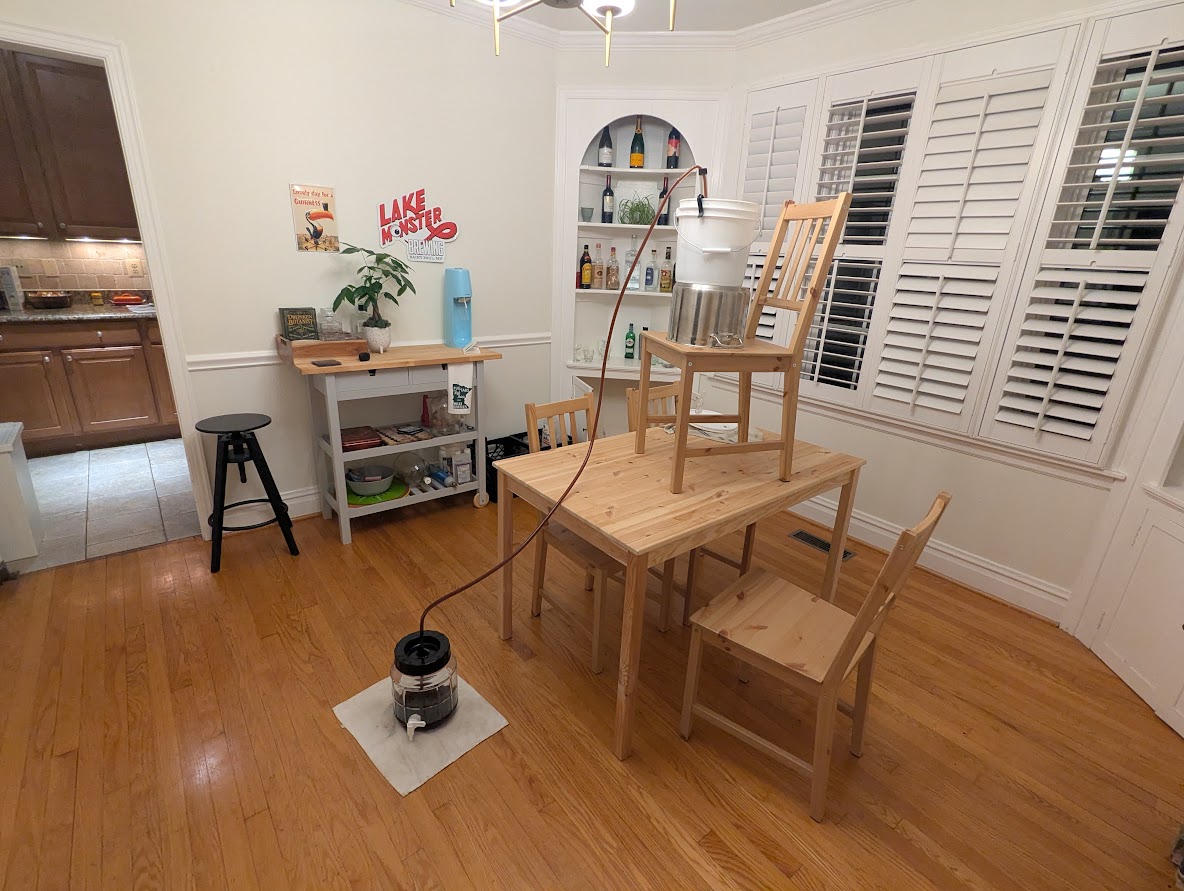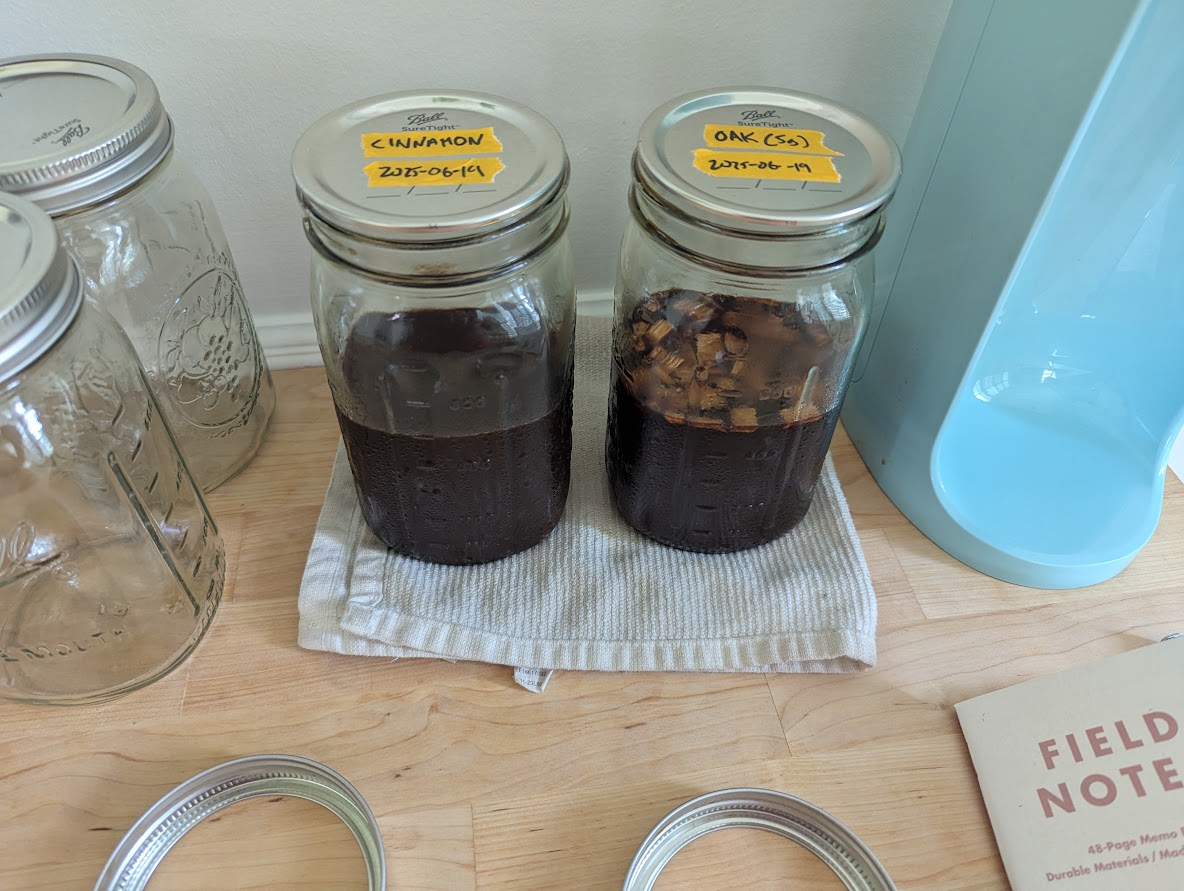Concocting Baleful Brews (Brewing Applejack)
A fun project to kick off (well, technically I finished before solstice) the summer! I’ve obviously done a handful of meads before, but a friend of mine inspired me to try doing an applejack (as well as helped me through the process and math), and sipping some alcohol in the woods on a summer night has a certain appeal.
Fundamentally, we are just making a hard apple cider and then concentrating it. I used a gallon of apple juice (Martinelli’s, I wanted to use unfiltered but I could only find glass liter bottles and not gallons and I needed a plastic gallon for later too) and provided the supplemental sugar with a combination of molasses and brown sugar. For yeast, I used Mangrove Jack’s M12 Kveik Yeast. It was in stock at my local brew shop and it goes up to 12%, plus it’s funky for fun. I figured I might also pitch a batch of mead off this yeast as well and see what happened. A handful of chopped raisins provide extra nutrients for the yeasties.
Stick it all in a big container, mix it up, slap an airlock on, and let it sit and bubble for a few weeks.

I should have taken an initial gravity reading here so I could get the ABV of my cider, but I forgot and didn’t feel like popping the bucket back open to measure, plus the jacking will make the ABV largely unknowable anyways, so we just assume it ferments will and hits 12% and call it a day.
Once we’re happy with the fermentation, we can siphon it off, cold crash in the fridge overnight, and then transfer to our vessel for freezing.

This should be an easy process, but I ended up making another mess while siphoning because of course I did. I initially went for my lovely 1.2gal glass fermenter since it had a spigot, but I hadn’t tightened the spigot properly so it was leaking, and I had to retransfer into 1gal carboy. The siphoning itself went mostly smoothly this time, though the bottling wand I got turned out to be a bad choice (too sensitive, basically. I’m sure it would work great when I actually go and bottle my next batch of whatever)
Oh well.
Anyways, after spending a night in the fridge, we poured it off carefully back into our plastic apple juice gallon and chucked that in the fridge to freeze solid. We’re aiming for about a liter of liquid in our final product, which will probably take a few rounds.

Turn it upside down over some jars and let it drip out ‘til the ice is clearish. I ended up getting ~1500ml before throwing the gallon back in the freezer for another go, and then got another 900ml and change for ~2500ml total.
For round two, we chuck all those jars back into our gallon and it goes back in the freezer for another day. This time we’ve got high enough alcohol percentage that it doesn’t freeze solid and slushes instead, which we can strain out (I used a steamer because apparently we don’t own a colander). Total yield of this round was ~1600ml liquid, so back in the freezer for round three, which put us as that even liter we were looking for.
After that, I split it out into two jars and tossed a cinnamon stick in one to age for a week or so, and 5 grams of light toast oak chips in the other to sit for a few months. Tried some of the cinnamon later that day and it was pretty good—I doubt much cinnamon flavor got in, but it was pretty dang smooth and no obvious off-flavors.

Gave it a week to age then thieved a bit to have a taste. Big whiff of alcohol sharpness at first that faded away, and once in the glass it had a definite nose of cinnamon. Almost savory taste that I can’t really pin down, but not harsh at all. Fairly dry with some acidity (but not an overwhelming amount, which is what I was worried about with the concentration.) Pleasant cinnamon-spice aftertaste and the apple flavors have faded a lot into the general character. Pretty tasty honestly; I pulled the cinnamon out and this jar will be “done”!
As for the oak, that still has some months to go, but I’m pretty excited for it. I think I’ll probably give it a taste at the 3 or 4-week mark to see how it’s doing